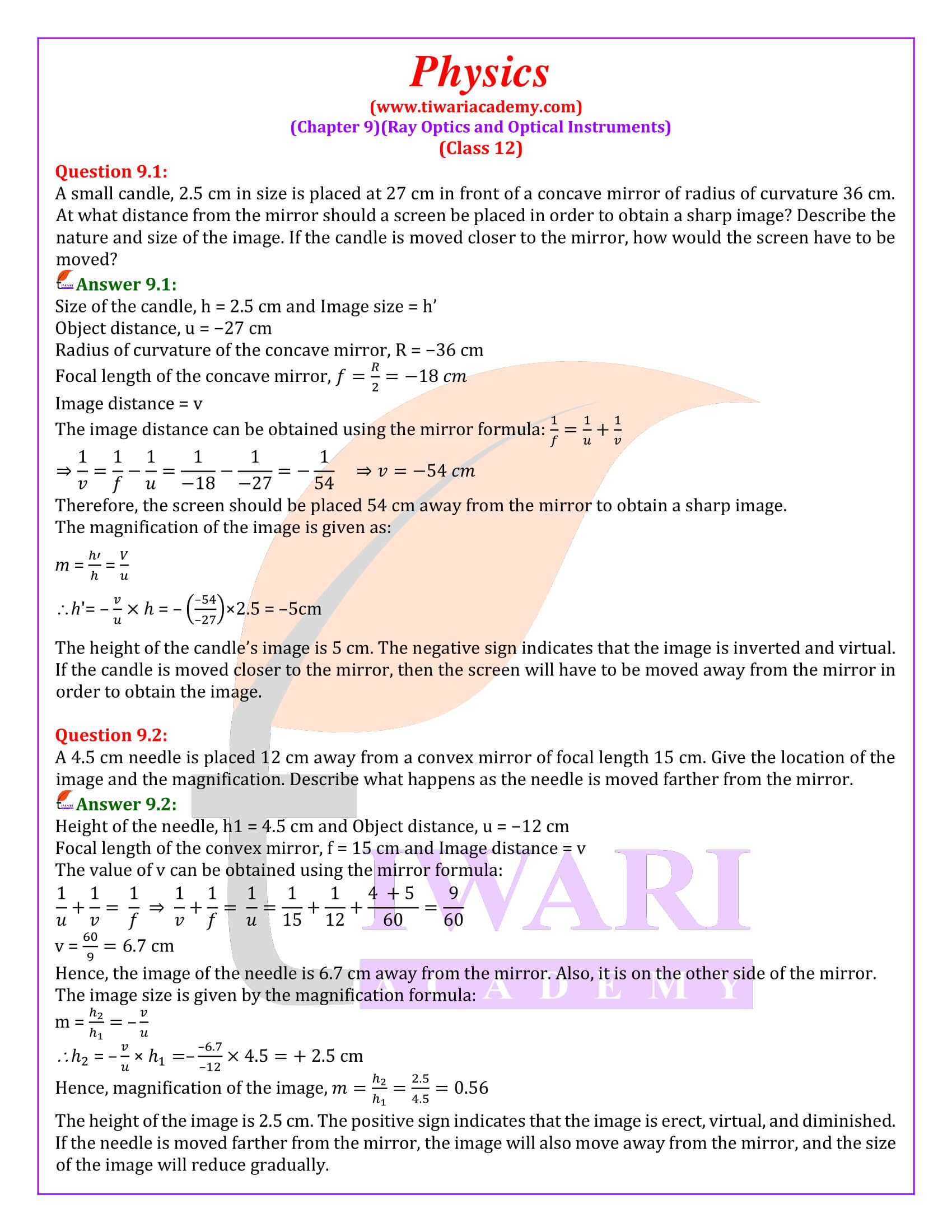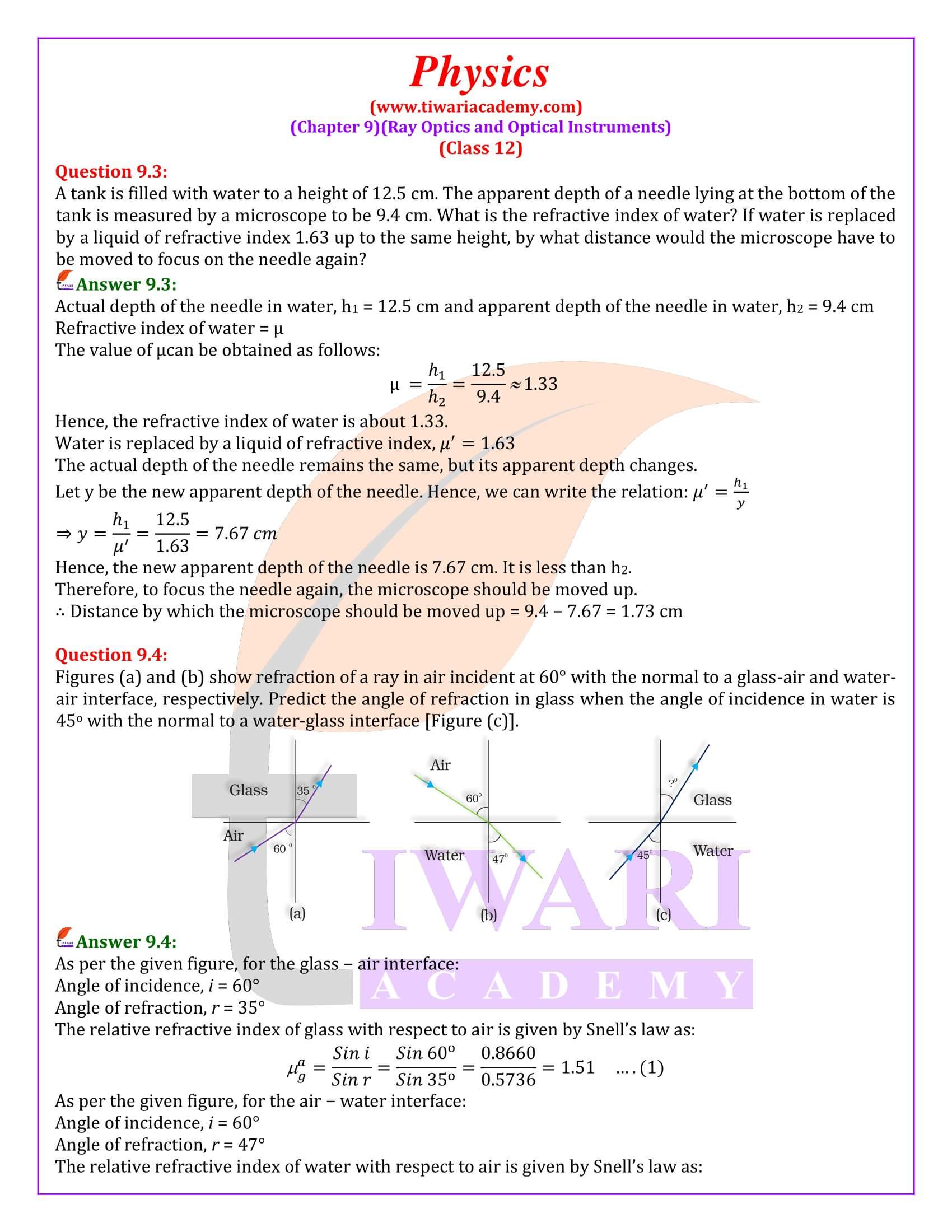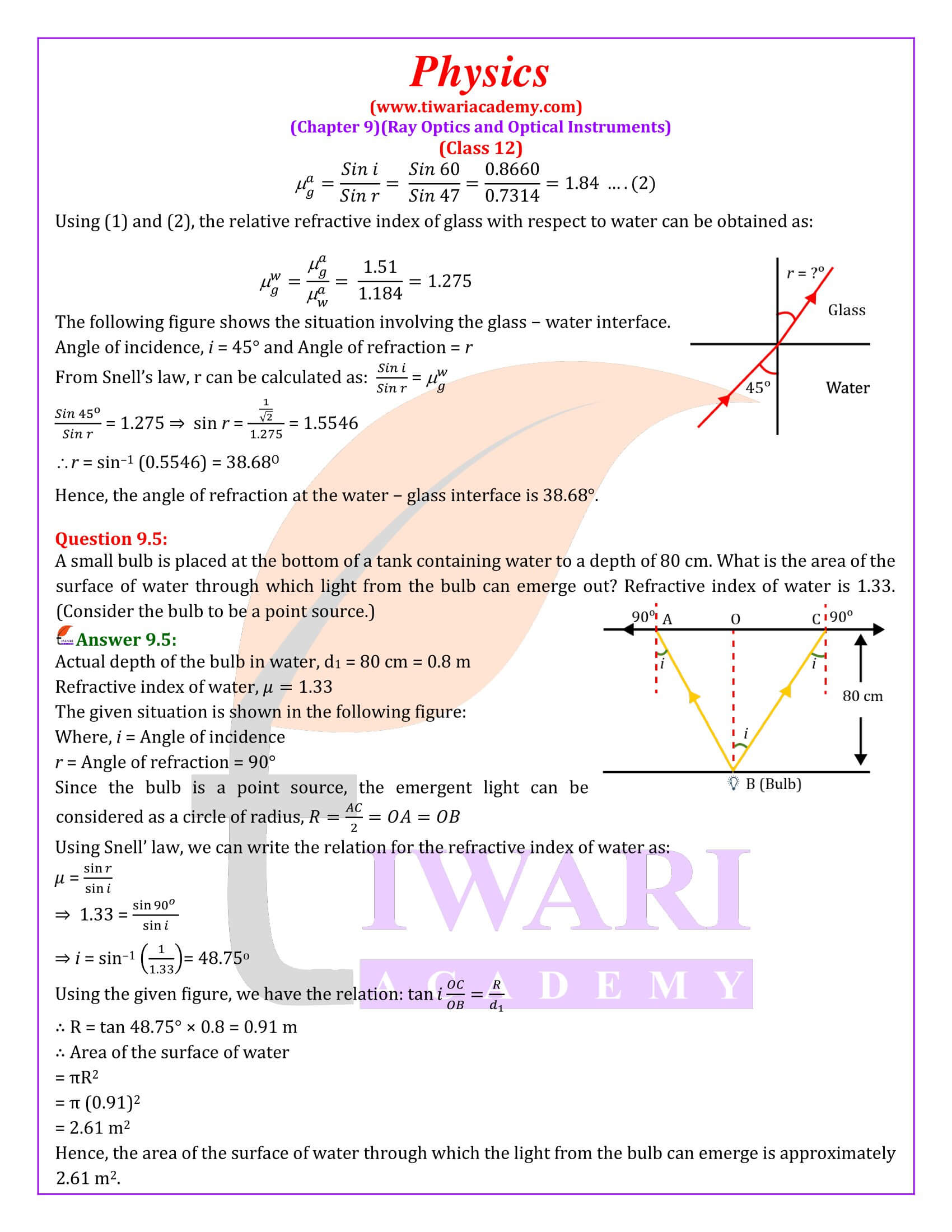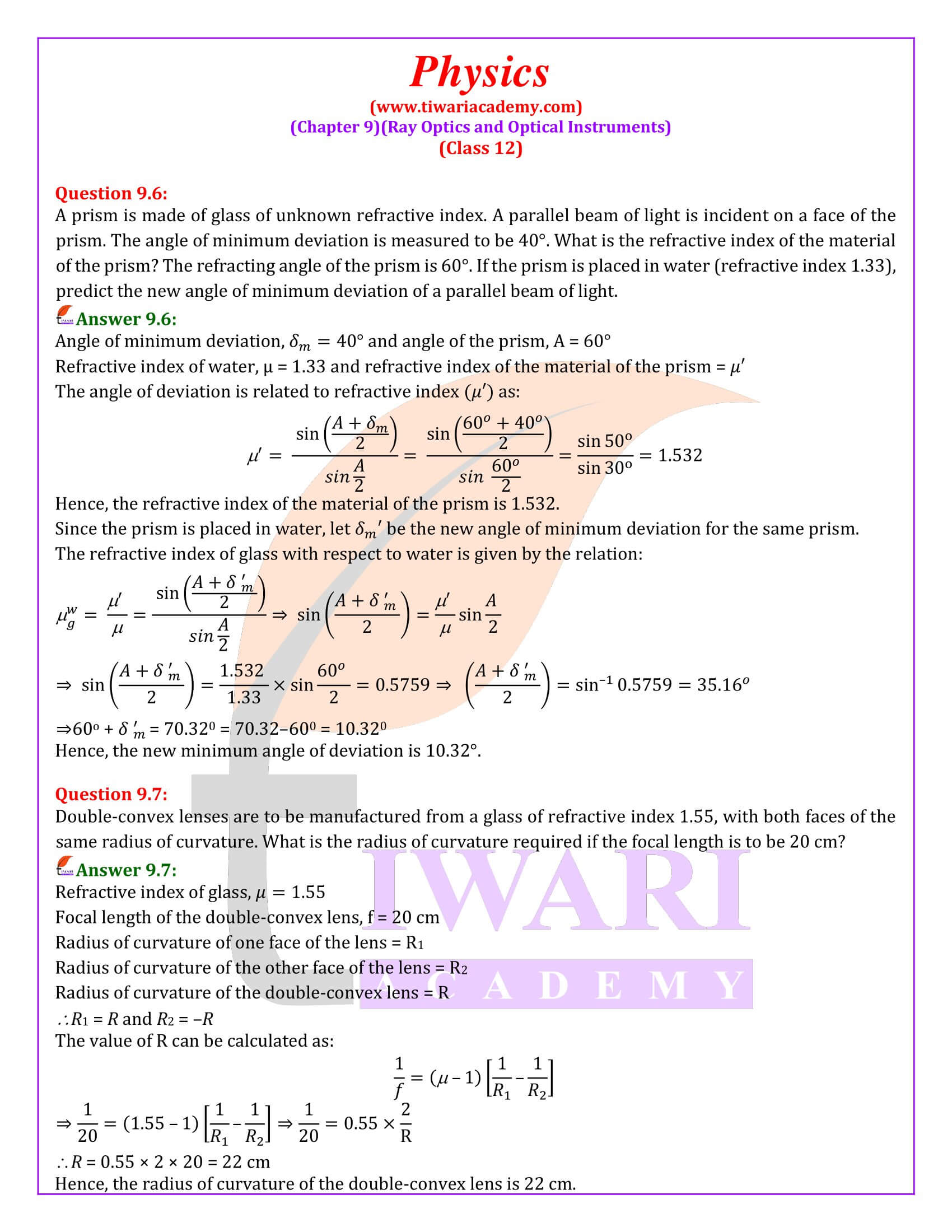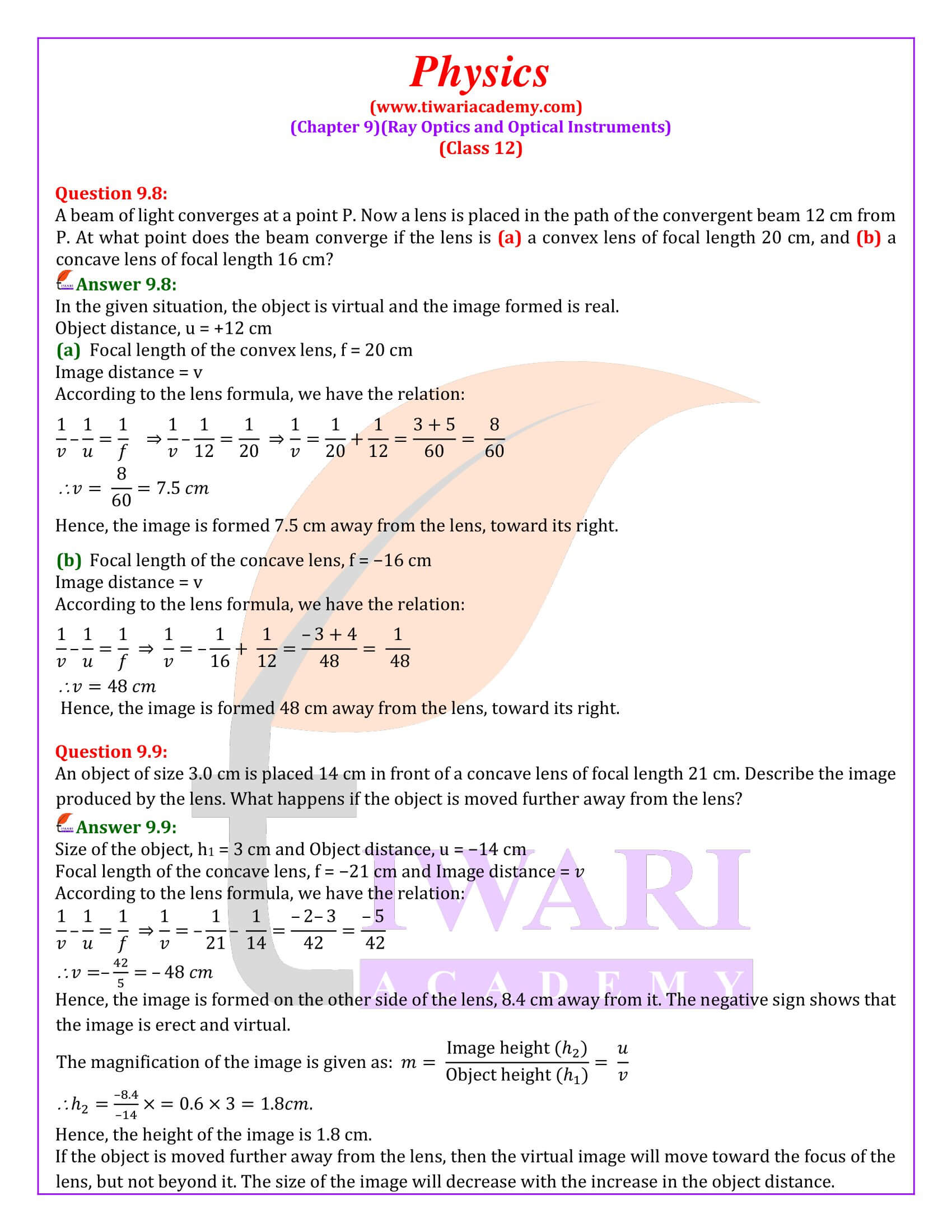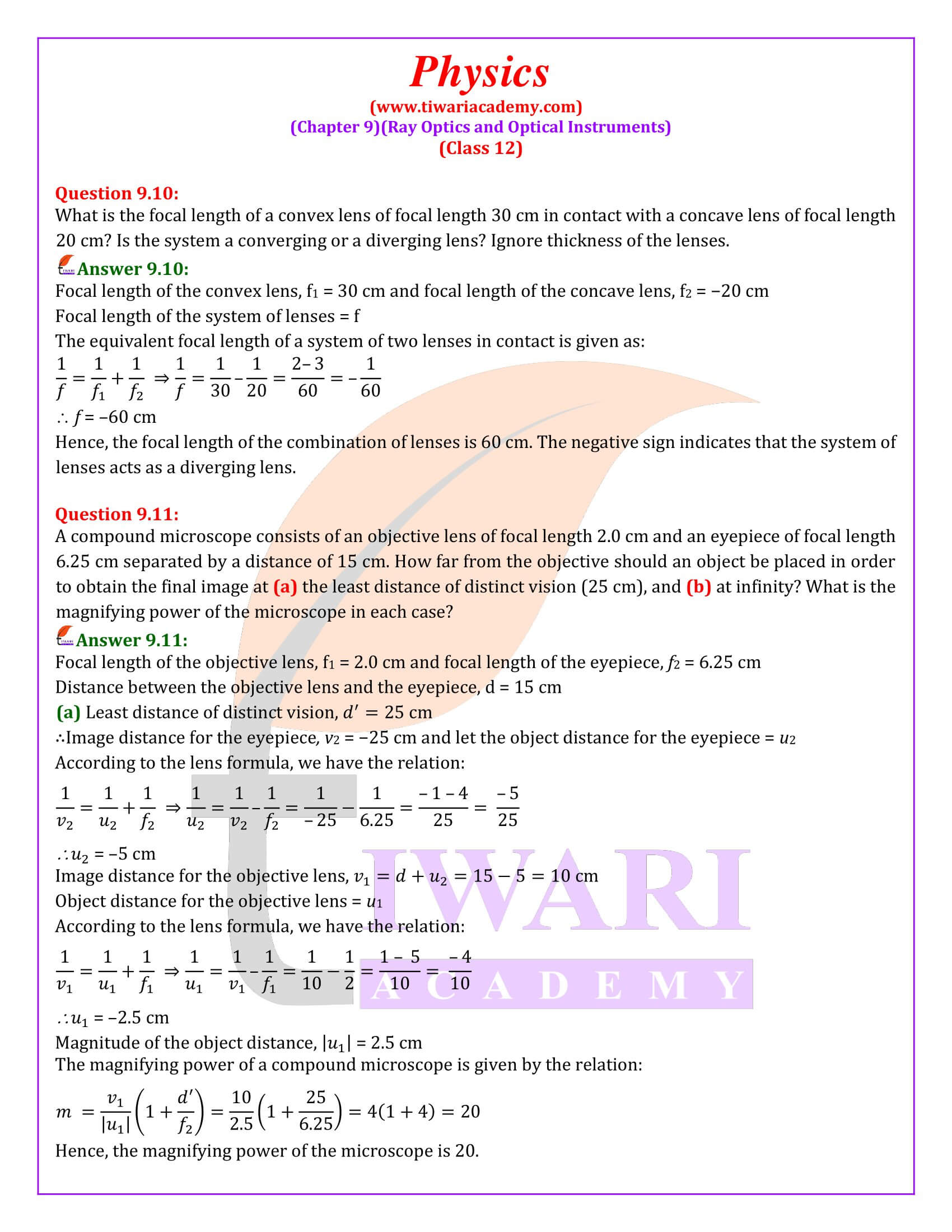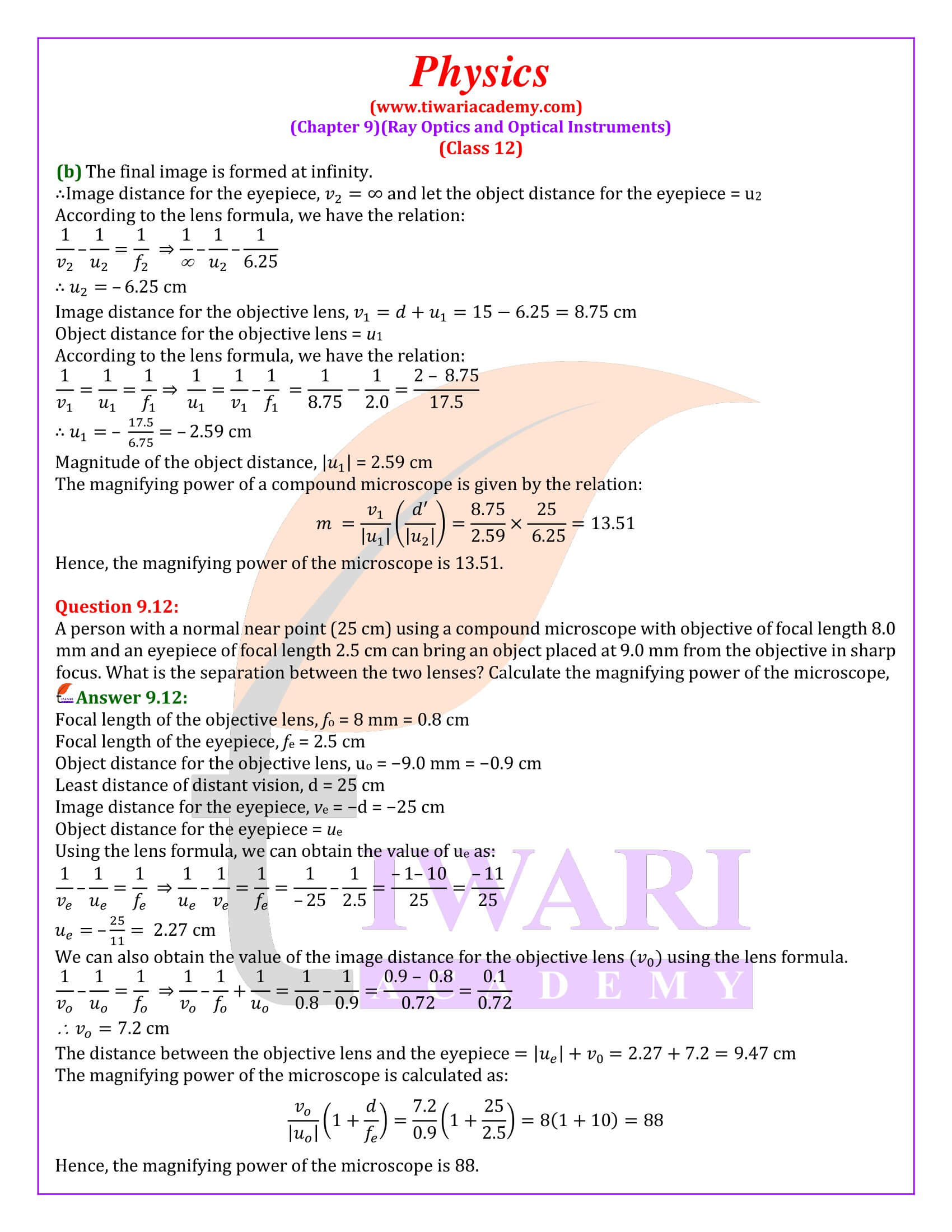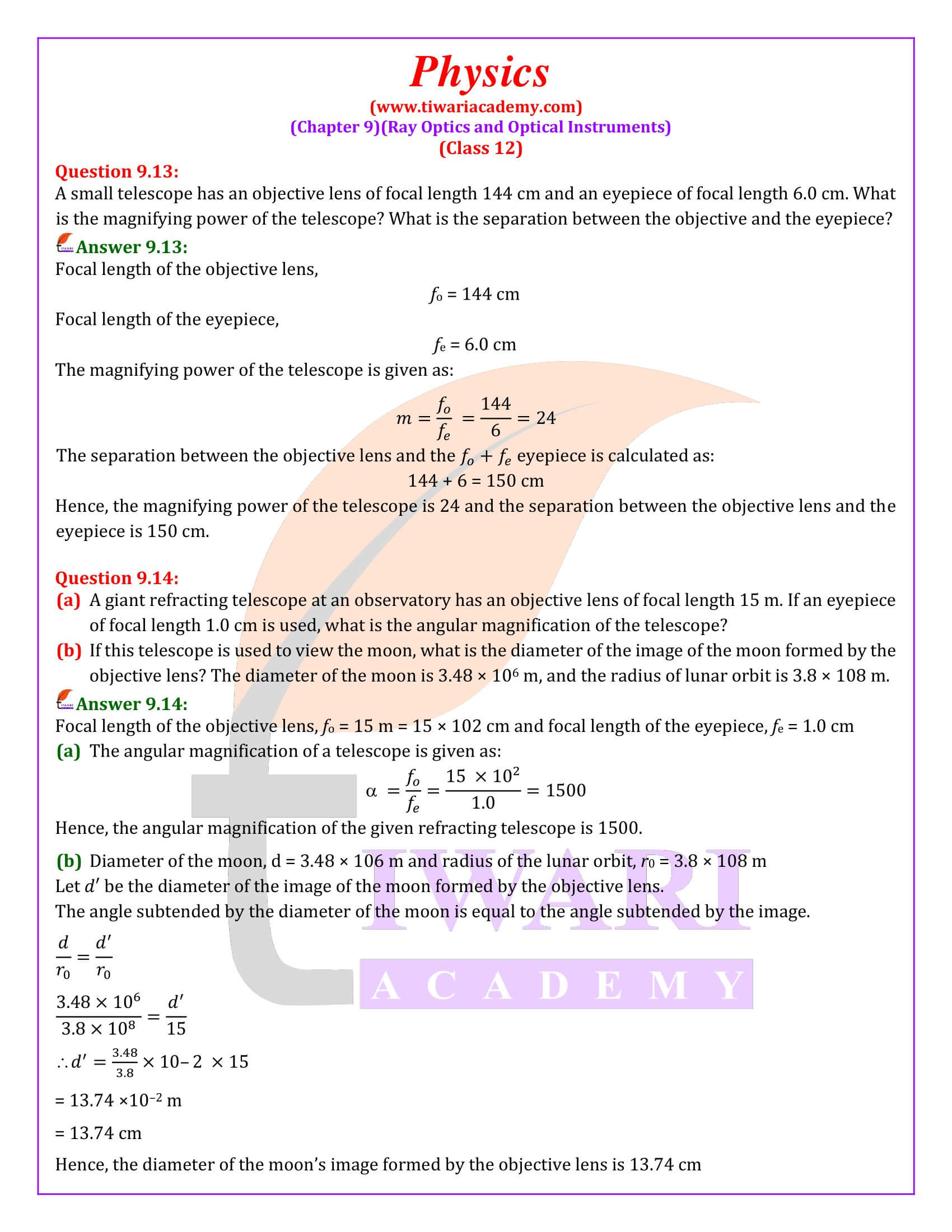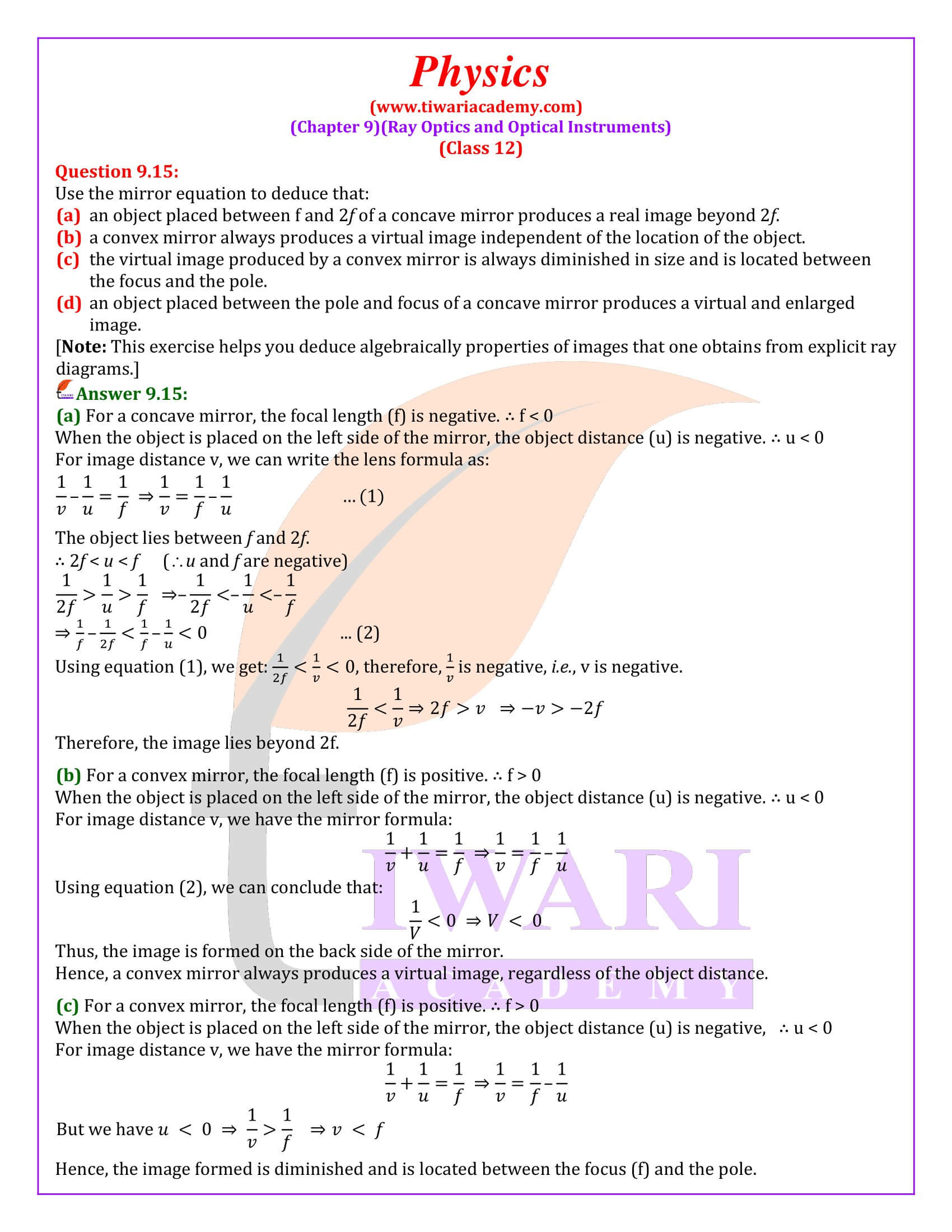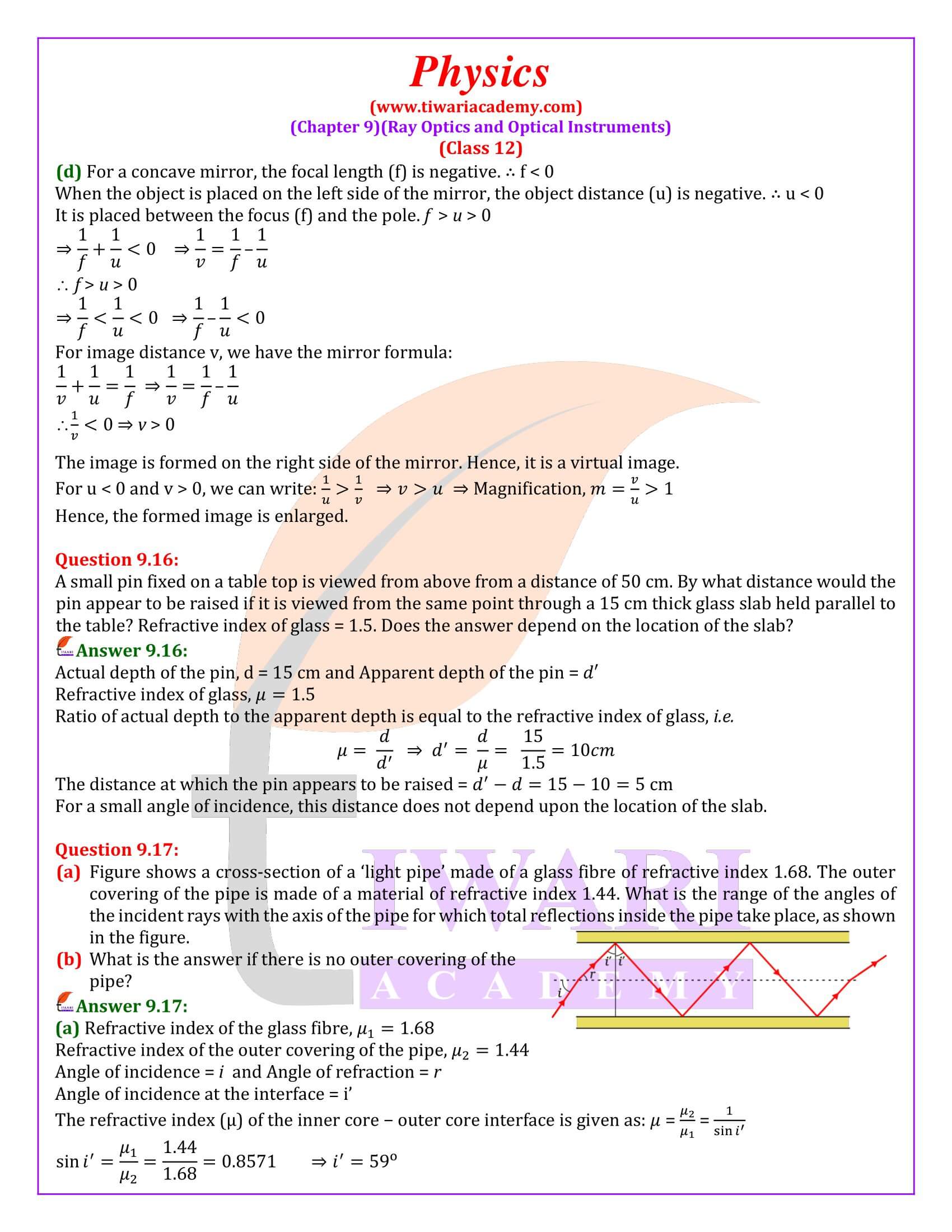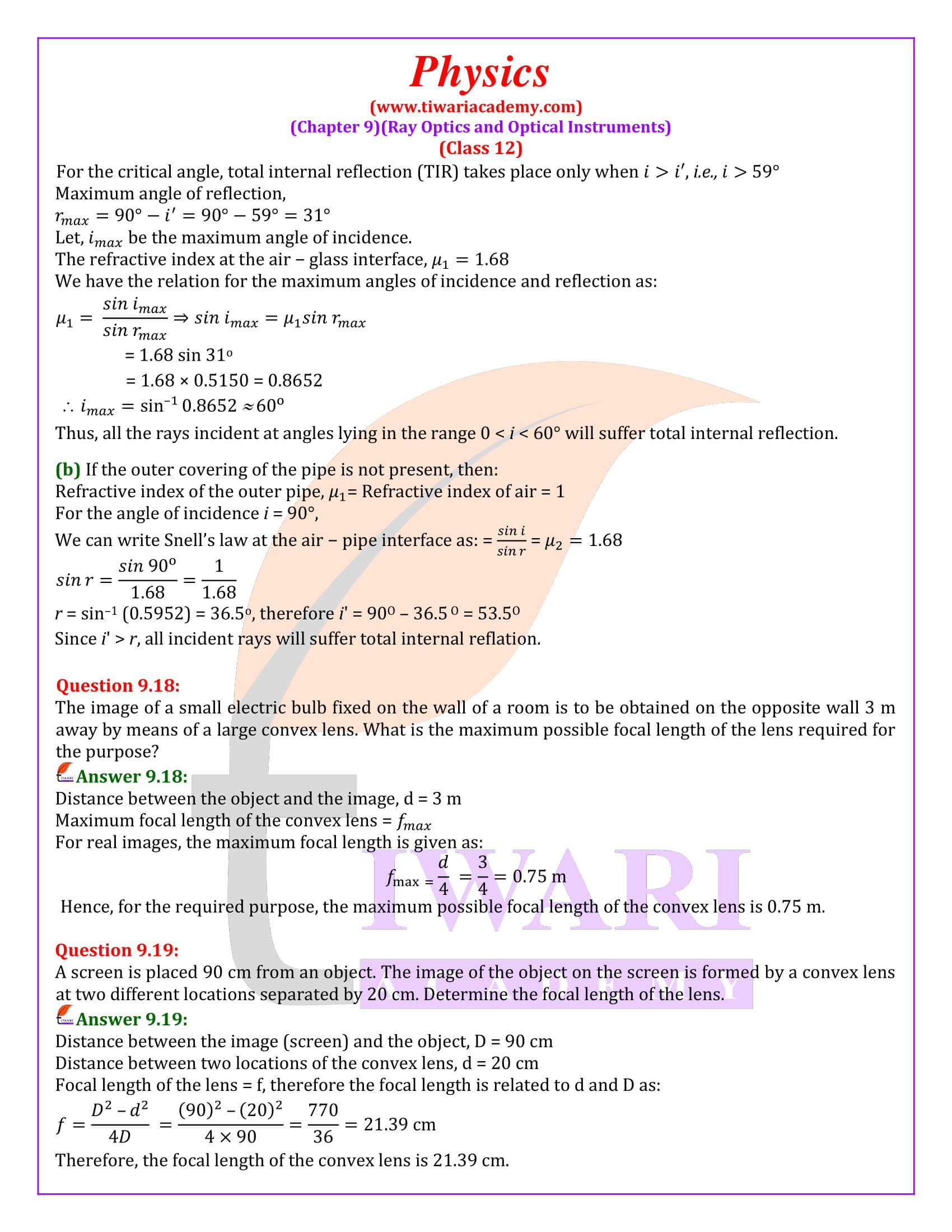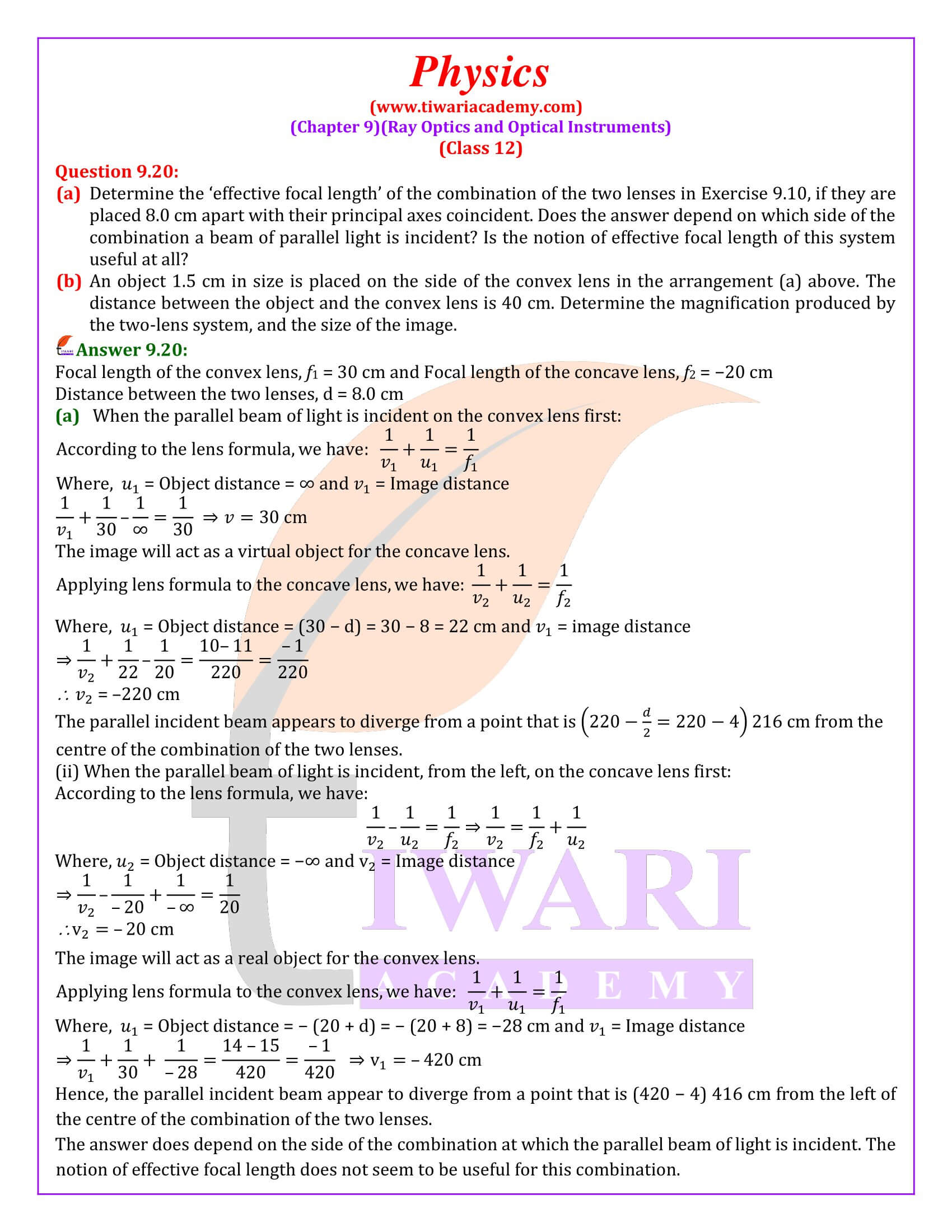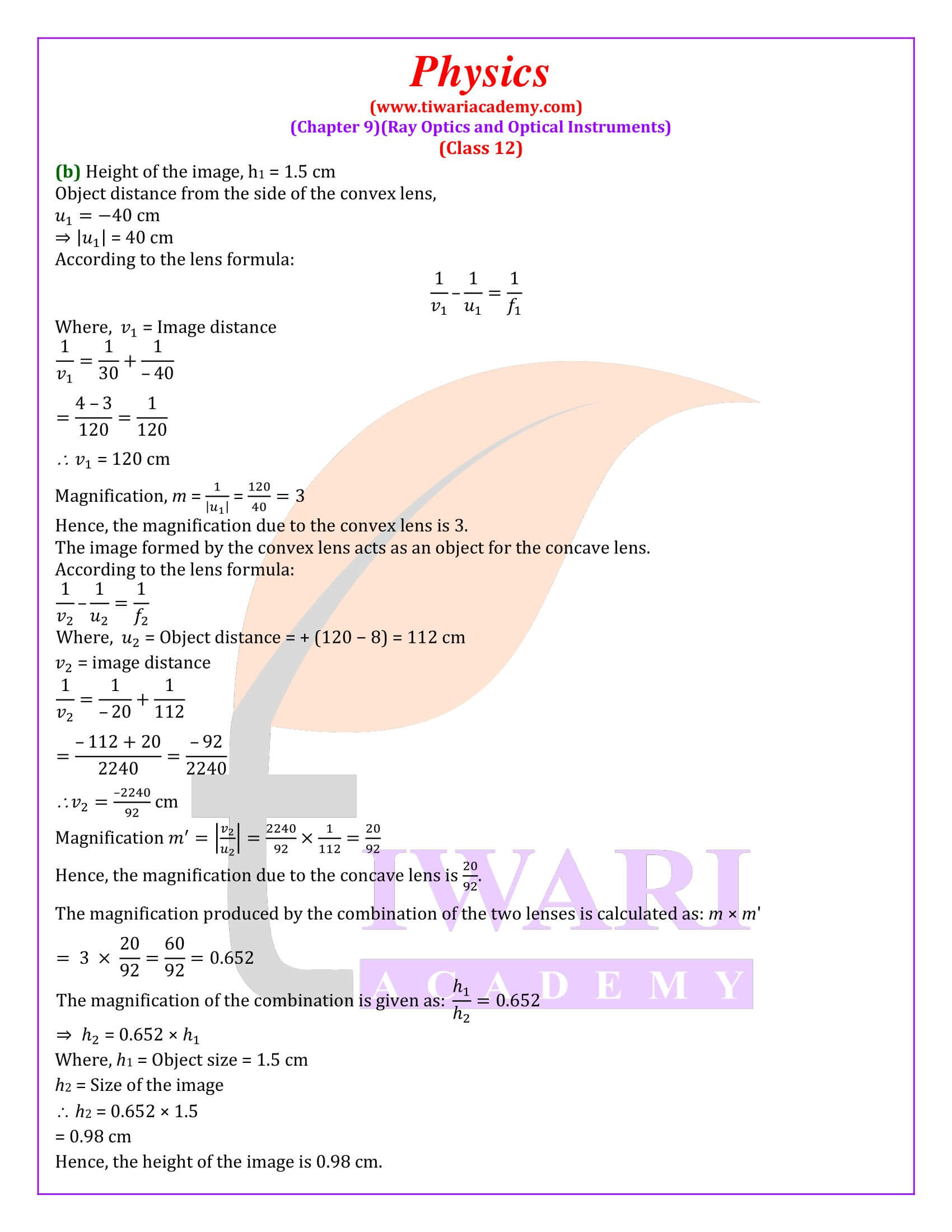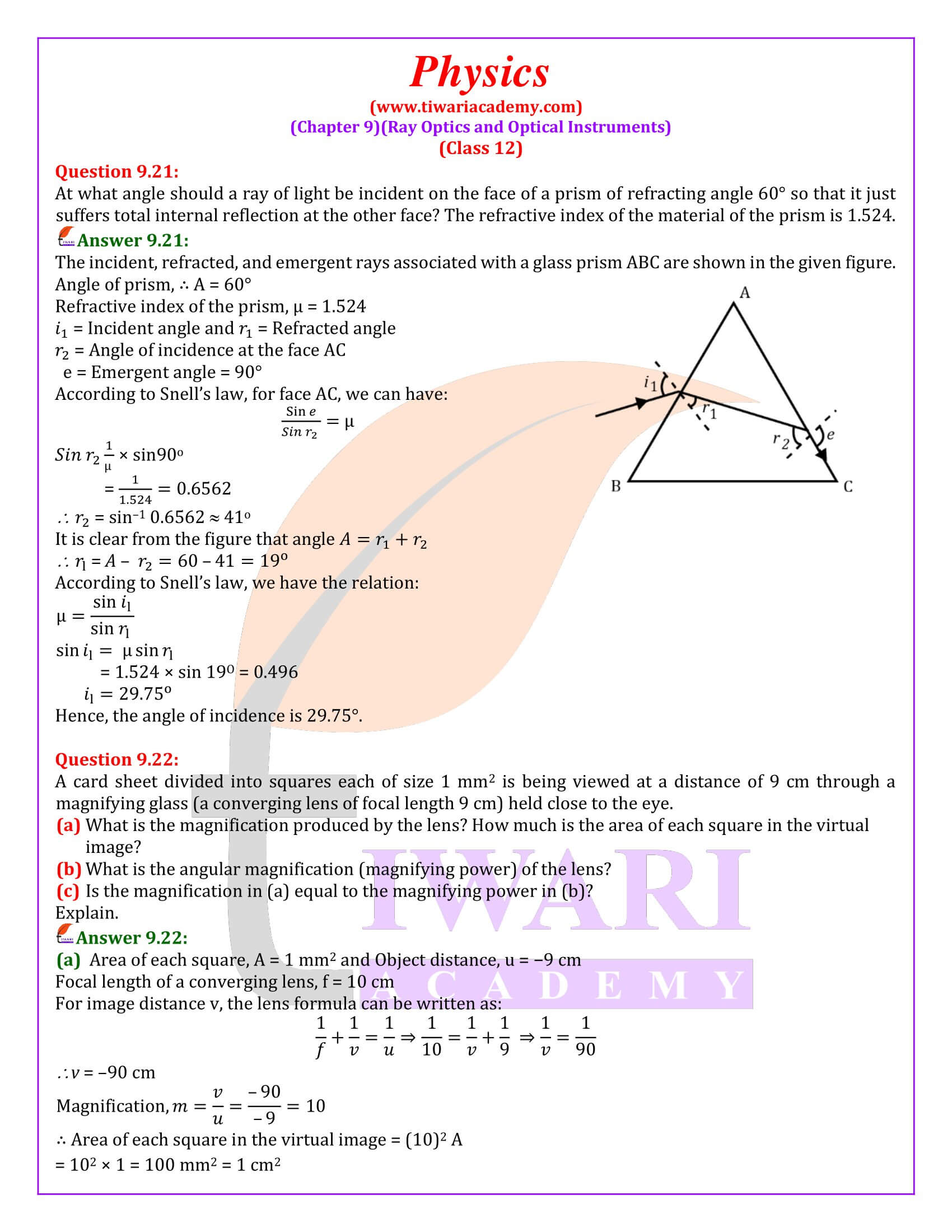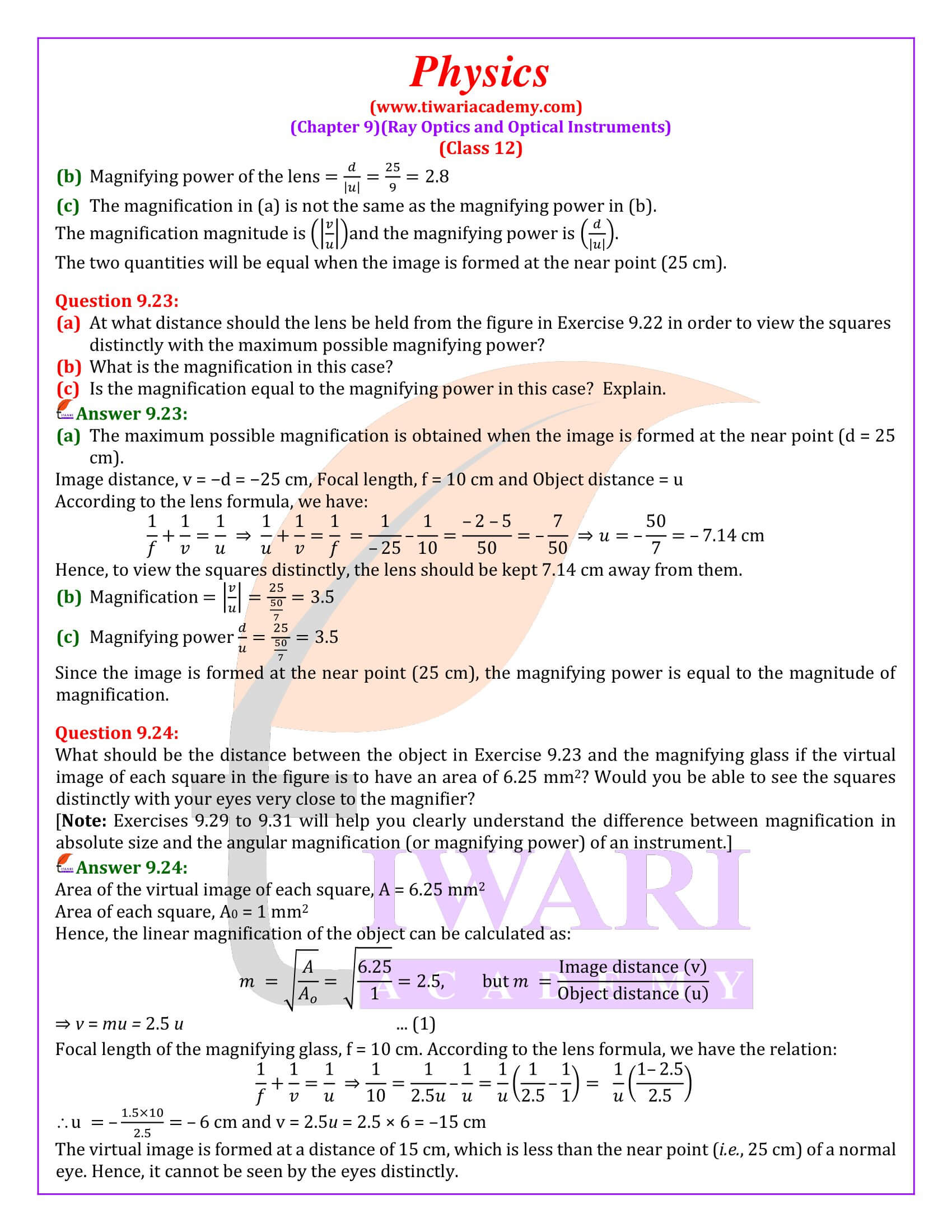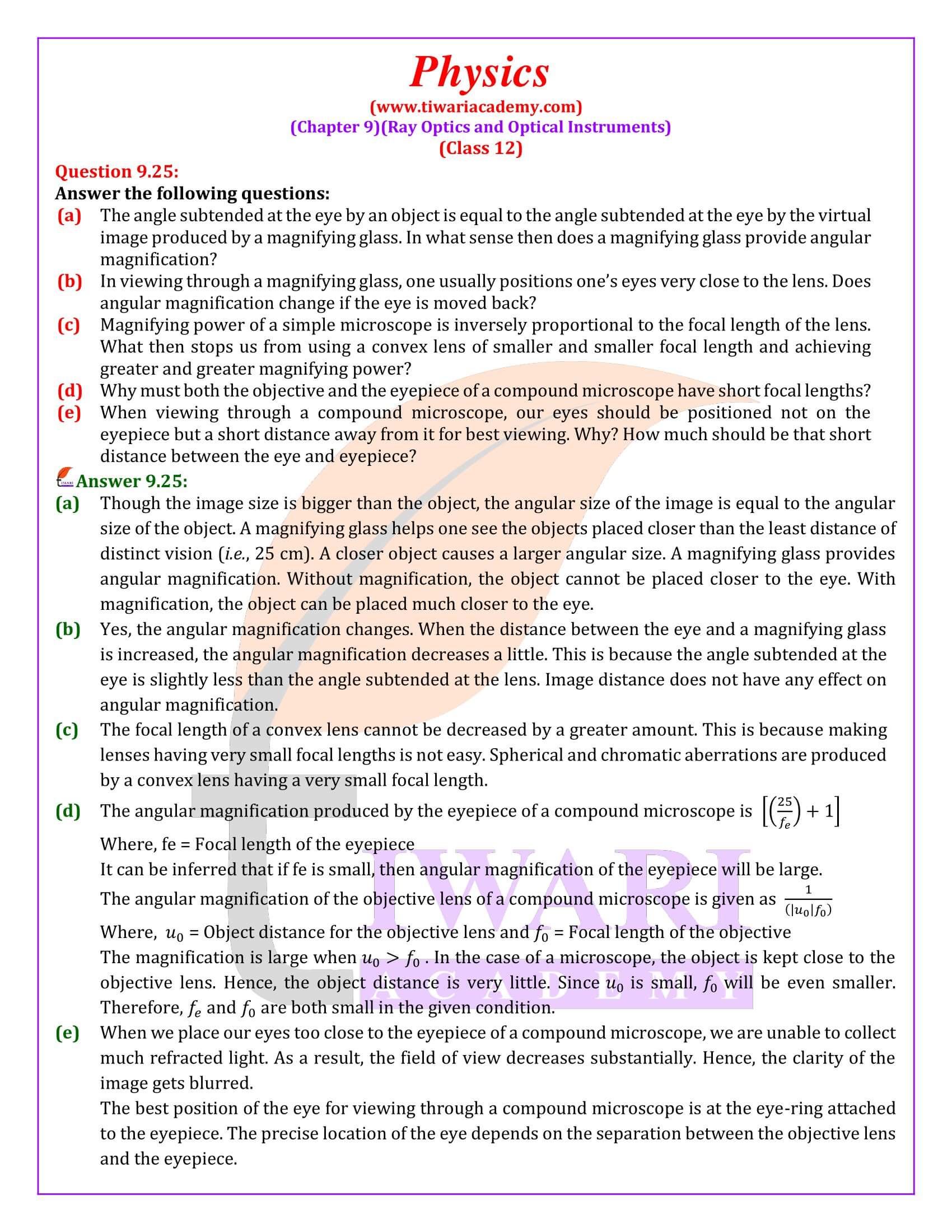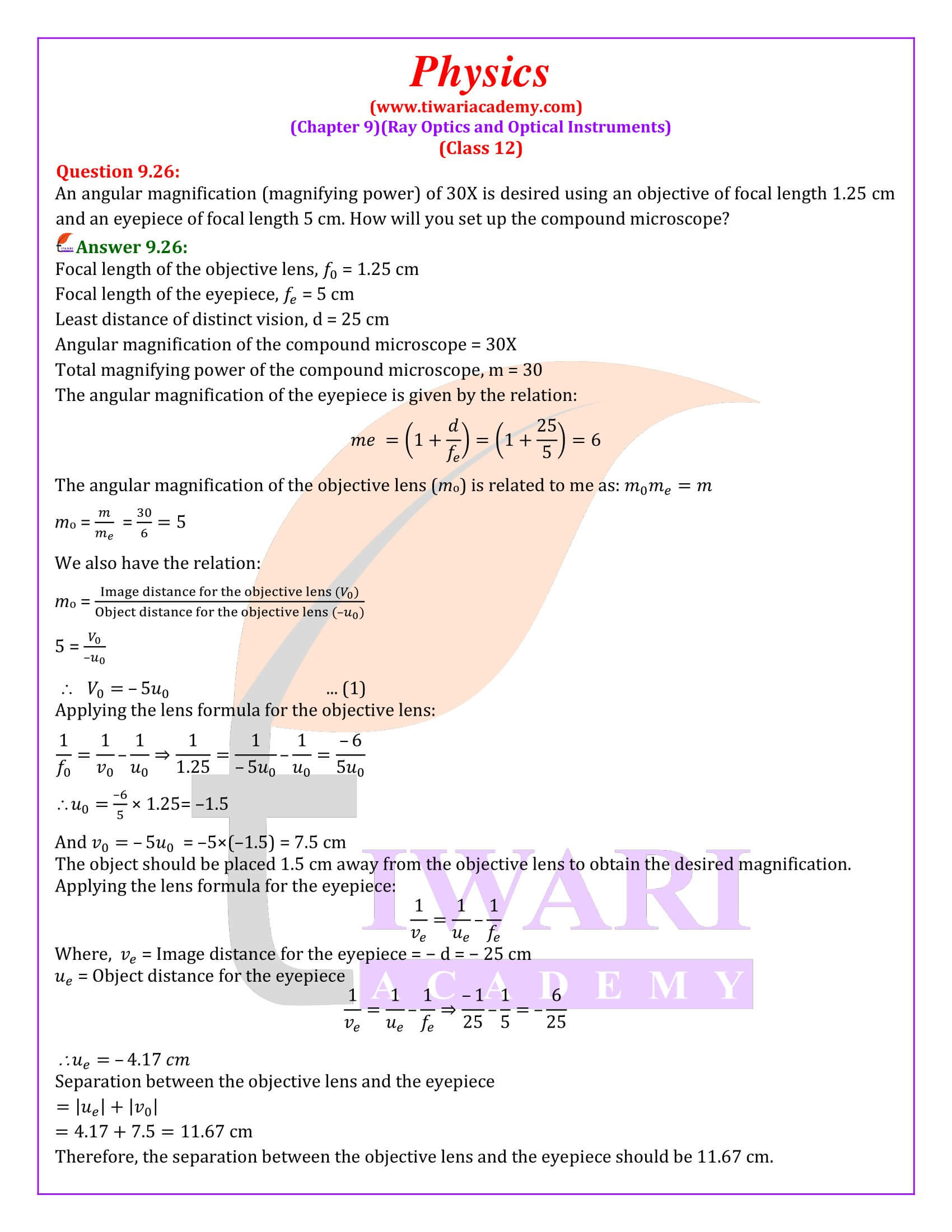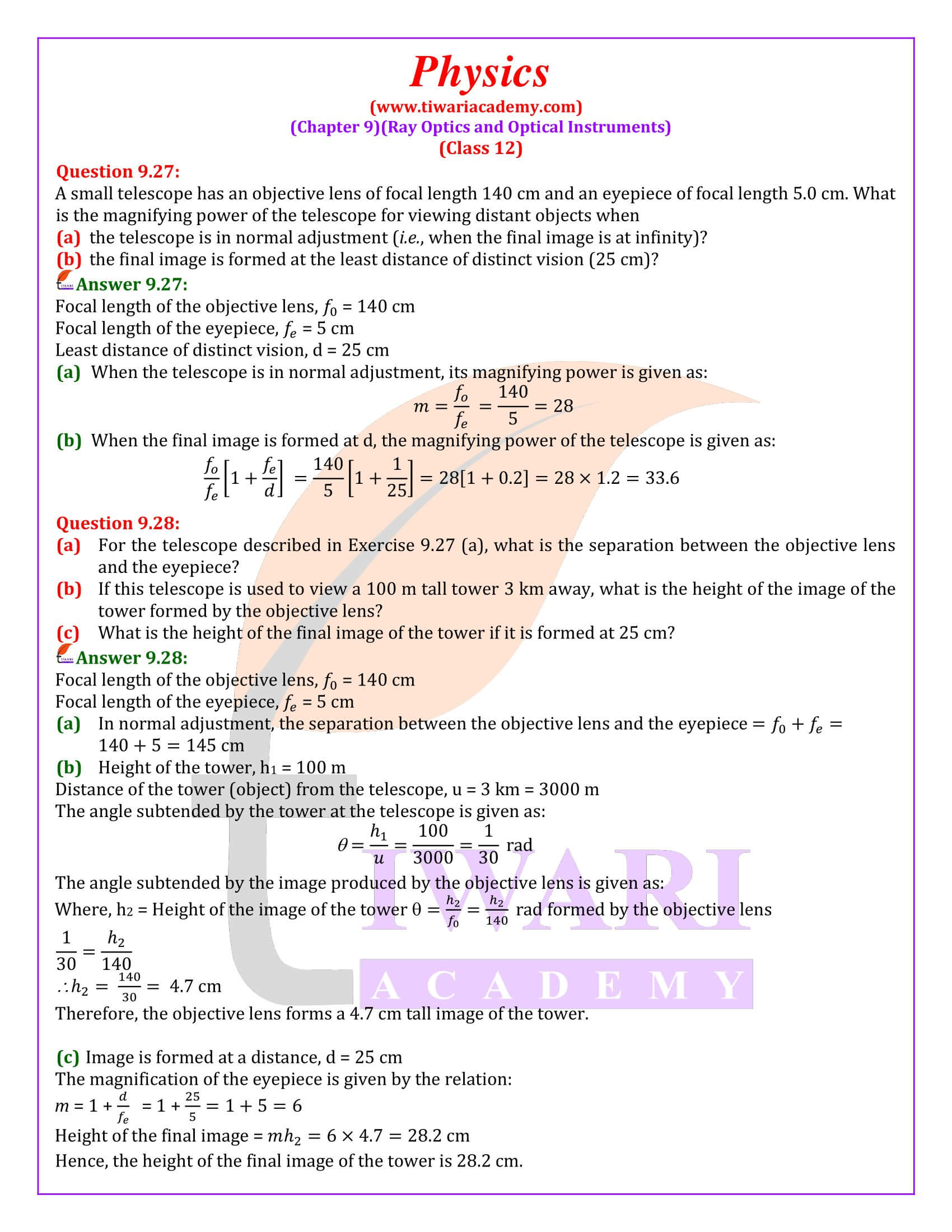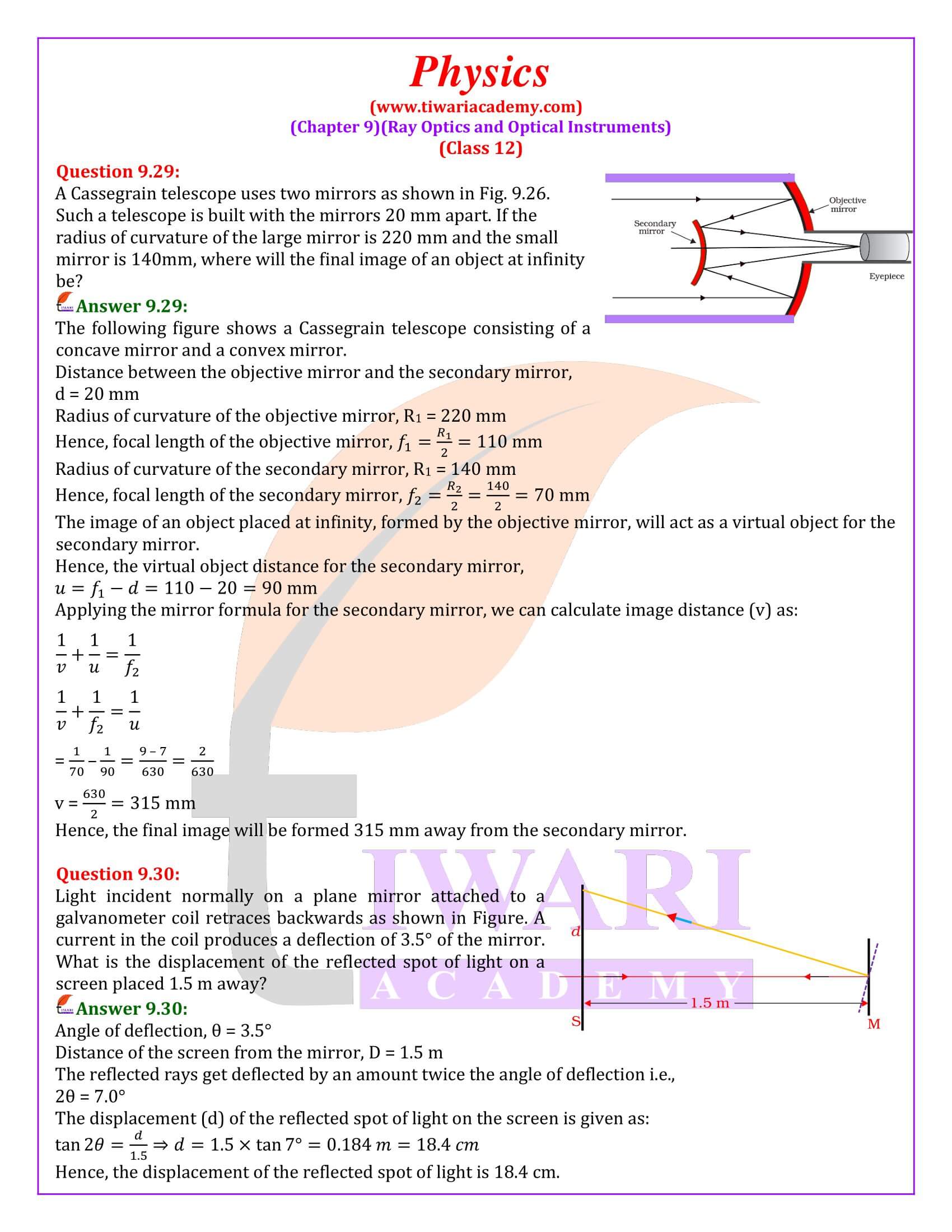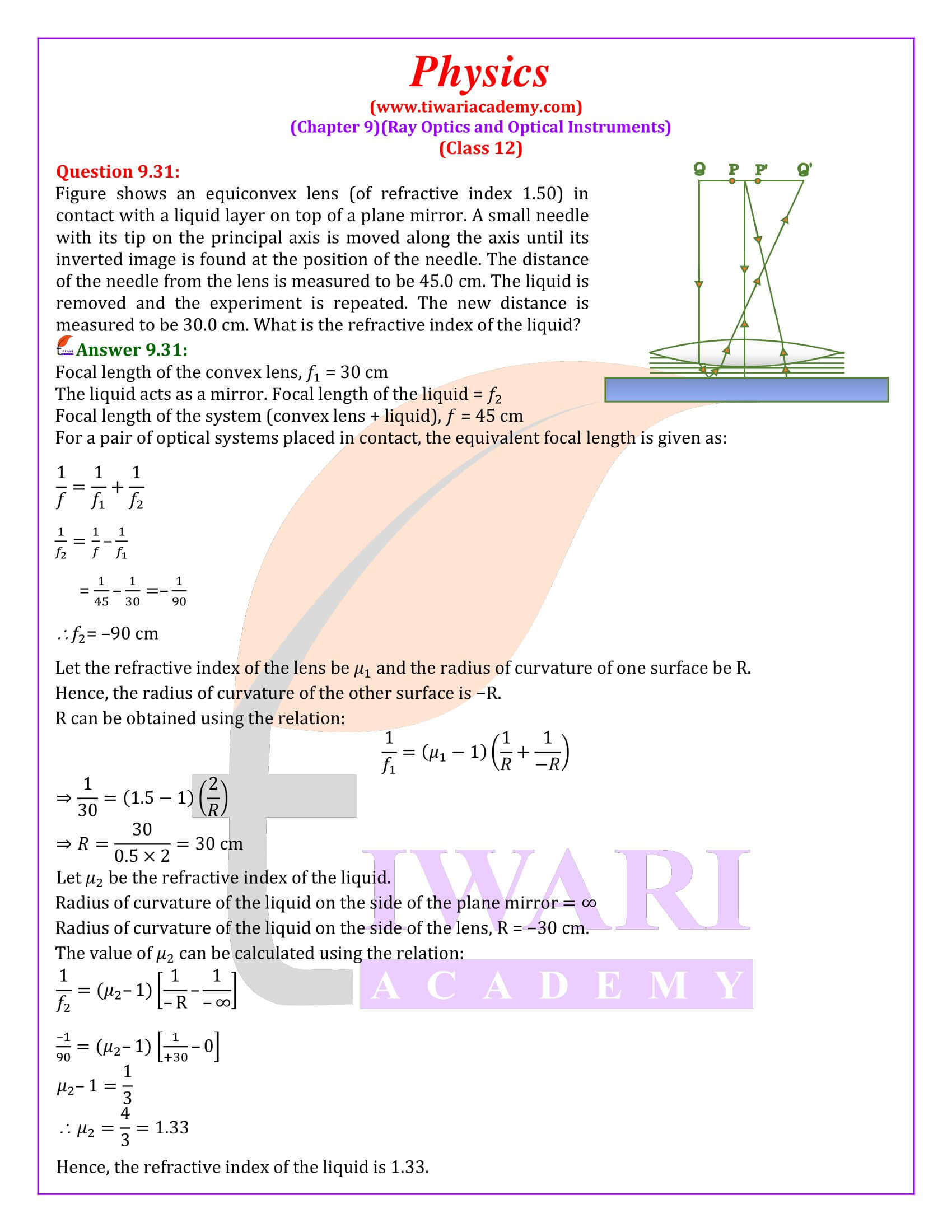NCERT Solutions for Class 12 Physics Chapter 9 Ray Optics and Optical Instruments in Hindi and English Medium updated for new session 2025-26. Get here revised and modified solutions of chapter 9 class 12th Physics based on new textbooks issued by NCERT for 2025-26 exams.
Viva Question Class 12 Physics
Preparation for Class 12 Physics Board Exam
Study Plan for Class 12 Board 2025
NCERT Solutions for Class 12 Physics Chapter 9
Chapter 9 Ray Optics and Optical Instruments Solutions
- Class 12 Physics Chapter 9 Exercises Solutions
- Class 12 Physics Chapter 9 Solutions in Hindi
- Class 12 Physics NCERT Book Chapter 9
- Class 12 Physics Revision Book Chapter 9
- Revision Book Answers
- Class 12 Physics Chapter 9 Revision Notes 1
- Class 12 Physics Chapter 9 Revision Notes 2
- Visit to 12th Physics Main Page
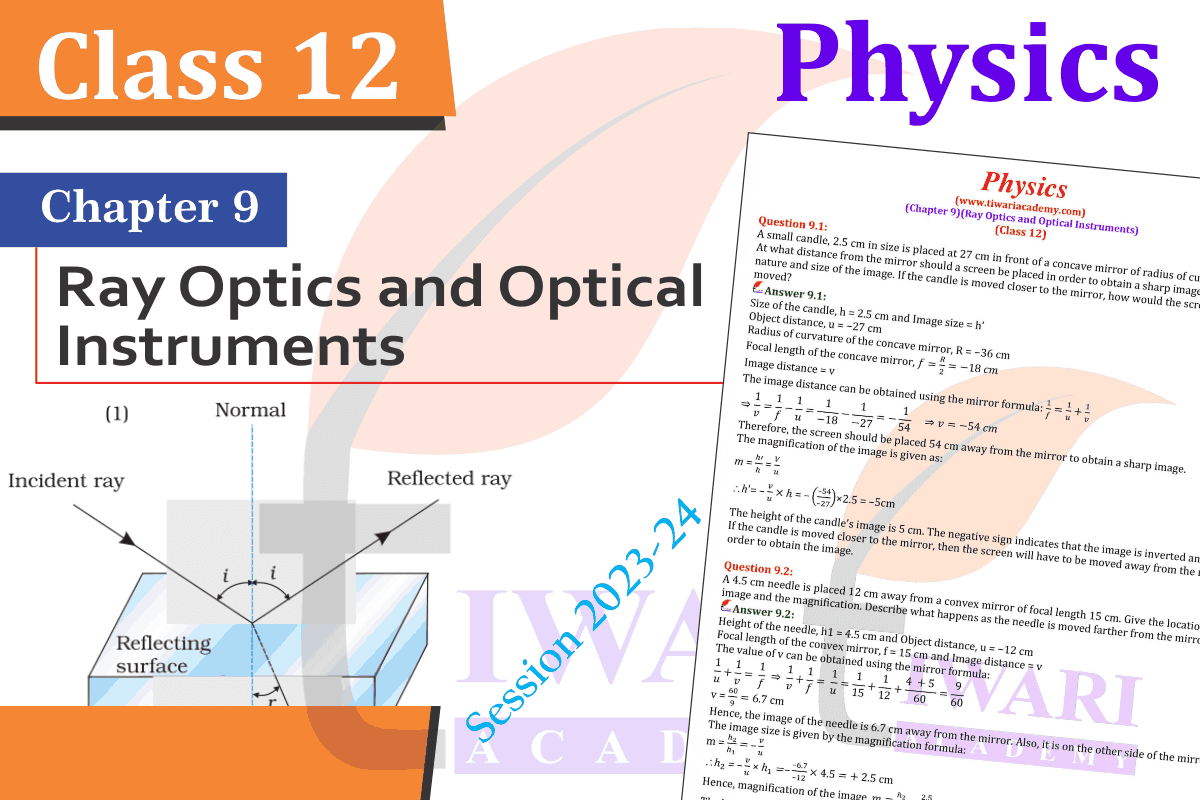
Get here end Exercises Questions Answers with solutions & Additional Exercises Solutions in PDF format to free download for 2025-26. Download CBSE and UP Board Solutions Offline Apps based on NCERT Books and CBSE Sols of other subjects also.
| Class: 12 | Physics |
| Chapter 9: | Ray Optics and Optical Instruments |
| Content Used: | Exercises and Additional Exercises |
| Mode of Content: | Text, Images and Videos |
| Session: | Academic Year 2025-26 |
| Medium Used: | English and Hindi |
Class 12 Physics Chapter 9 Solutions in English
NCERT Solutions for Class 12 Physics Chapter 9 in PDF format to free download or use online without downloading. Ask your doubts related to NIOS Board as well as CBSE Board through discussion forum. Download latest NCERT Books 2025-26 based on latest CBSE Syllabus.
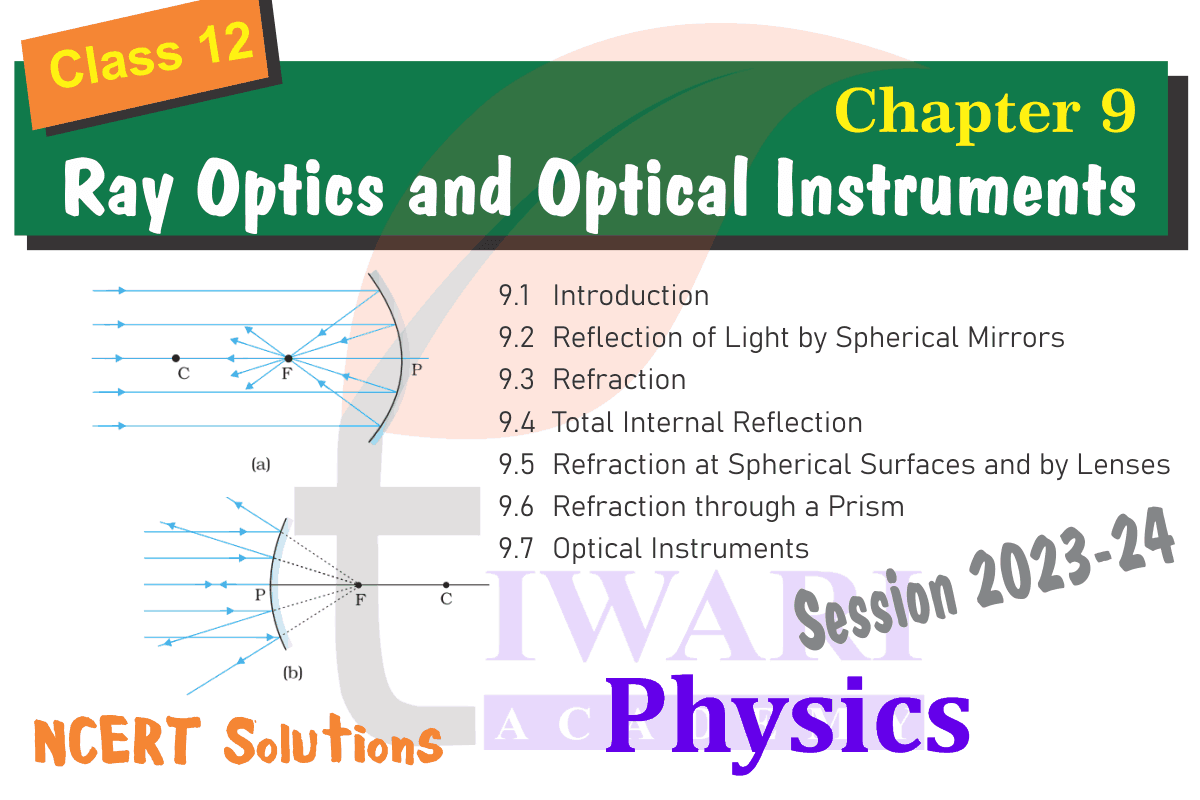
Important Questions for practice
1. With the help of ray diagram explain the phenomenon of total internal reflection. Obtain the relation between critical angle and refractive indices of two media. Draw ray diagram to show how right angled isosceles prism can be used to: (i) Deviate the ray through 180°. (ii) Deviate the ray through 90°.
(iii) Invert the ray.
2. The refractive index of medium is 1.5. A beam of light of wavelength 6000 A° enters in the medium from air. Find wavelength and frequency of light in the medium.
3. An object of length 2.5cm is placed at a distance of 1.5f from a concave mirror where f is the focal length of the mirror. The length of object is perpendicular to principal axis. Find the size of image. Is the image erect or inverted?
4. For a man shortest distance of distinct vision is 20 cm. What will be the type and power of lens which would enable him to read a book at a distance of 60 cm?
5. A hypermetropic person whose near point is at 100 cm wants to read a book. Find the nature and power of the lens needed.
Questions from Board Papers
1. A near sighted person can clearly see objects up to a distance of 1.5m. Calculate power of the concave lens of focal length 1.5 m for the remedy of this defect. (P = – 0.67D)
2. Two poles-one 4m high and the other is 4.5 m high are situated at distance 40m and 50m respectively from an eye. Which pole will appear taller?
3. The angle subtended at the eye by an object is equal to the angle subtended at the eye by the virtual image produced by a magnifying glass. In what sense then does magnifying glass produce angular magnification?
4. You are provided with four convex lenses of focal length 1cm, 3cm, 10cm and 100 cm. Which two would you prefer for a microscope and which two for a telescope.
5. A microscope is focussed on a dot at the bottom of the beaker. Some oil is poured into the beaker to a height of ‘b’ cm and it is found that microscope has to raise through vertical distance of ‘a’ cm to bring the dot again into focus. Express refractive index of oil is terms of a and b.
Important Questions on 12th Physics Chapter 9
You have learnt that plane and convex mirrors produce virtual images of objects. Can they produce real images under some circumstances? Explain.
Yes Plane and convex mirrors can produce real images as well. If the object is virtual, i.e., if the light rays converging at a point behind a plane mirror (or a convex mirror) are reflected to a point on a screen placed in front of the mirror, then a real image will be formed.
A virtual image, we always say, cannot be caught on a screen. Yet when we ‘see’ a virtual image, we are obviously bringing it on to the ‘screen’ (i.e., the retina) of our eye. Is there a contradiction?
No A virtual image is formed when light rays diverge. The convex lens of the eye causes these divergent rays to converge at the retina. In this case, the virtual image serves as an object for the lens to produce a real image.
A diver under water, looks obliquely at a fisherman standing on the bank of a lake. Would the fisherman look taller or shorter to the diver than what he actually is?
The diver is in the water and the fisherman is on land (i.e., in air). Water is a denser medium than air. It is given that the diver is viewing the fisherman. This indicates that the light rays are travelling from a denser medium to a rarer medium. Hence, the refracted rays will move away from the normal. As a result, the fisherman will appear to be taller.
Does the apparent depth of a tank of water change if viewed obliquely? If so, does the apparent depth increase or decrease?
Yes; Decrease The apparent depth of a tank of water changes when viewed obliquely. This is because light bends on travelling from one medium to another. The apparent depth of the tank when viewed obliquely is less than the near-normal viewing.
The refractive index of diamond is much greater than that of ordinary glass. Is this fact of some use to a diamond cutter?
Yes The refractive index of diamond (2.42) is more than that of ordinary glass (1.5). The critical angle for diamond is less than that for glass. A diamond cutter uses a large angle of incidence to ensure that the light entering the diamond is totally reflected from its faces. This is the reason for the sparkling effect of a diamond.
Does short-sightedness (myopia) or long-sightedness (hypermetropia) imply necessarily that the eye has partially lost its ability of accommodation? If not, what might cause these defects of vision?
A myopic or hypermetropic person can also possess the normal ability of accommodation of the eye-lens. Myopia occurs when the eye-balls get elongated from front to back. Hypermetropia occurs when the eye-balls get shortened. When the eye-lens loses its ability of accommodation, the defect is called presbyopia.
A person looking at a person wearing a shirt with a pattern comprising vertical and horizontal lines is able to see the vertical lines more distinctly than the horizontal ones. What is this defect due to? How is such a defect of vision corrected?
In the given case, the person is able to see vertical lines more distinctly than horizontal lines. This means that the refracting system (cornea and eye-lens) of the eye is not working in the same way in different planes. This defect is called astigmatism. The person’s eye has enough curvature in the vertical plane. However, the curvature in the horizontal plane is insufficient. Hence, sharp images of the vertical lines are formed on the retina, but horizontal lines appear blurred. This defect can be corrected by using cylindrical lenses.
The angle subtended at the eye by an object is equal to the angle subtended at the eye by the virtual image produced by a magnifying glass. In what sense then does a magnifying glass provide angular magnification?
Though the image size is bigger than the object, the angular size of the image is equal to the angular size of the object. A magnifying glass helps one see the objects placed closer than the least distance of distinct vision (i.e., 25 cm). A closer object causes a larger angular size. A magnifying glass provides angular magnification. Without magnification, the object cannot be placed closer to the eye. With magnification, the object can be placed much closer to the eye.
In viewing through a magnifying glass, one usually positions one’s eyes very close to the lens. Does angular magnification change if the eye is moved back?
Yes, the angular magnification changes. When the distance between the eye and a magnifying glass is increased, the angular magnification decreases a little. This is because the angle subtended at the eye is slightly less than the angle subtended at the lens. Image distance does not have any effect on angular magnification.
Magnifying power of a simple microscope is inversely proportional to the focal length of the lens. What then stops us from using a convex lens of smaller and smaller focal length and achieving greater and greater magnifying power?
The focal length of a convex lens cannot be decreased by a greater amount. This is because making lenses having very small focal lengths is not easy. Spherical and chromatic aberrations are produced by a convex lens having a very small focal length.
When viewing through a compound microscope, our eyes should be positioned not on the eyepiece but a short distance away from it for best viewing. Why? How much should be that short distance between the eye and eyepiece?
When we place our eyes too close to the eyepiece of a compound microscope, we are unable to collect much refracted light. As a result, the field of view decreases substantially. Hence, the clarity of the image gets blurred. The best position of the eye for viewing through a compound microscope is at the eye-ring attached to the eyepiece. The precise location of the eye depends on the separation between the objective lens and the eyepiece.
